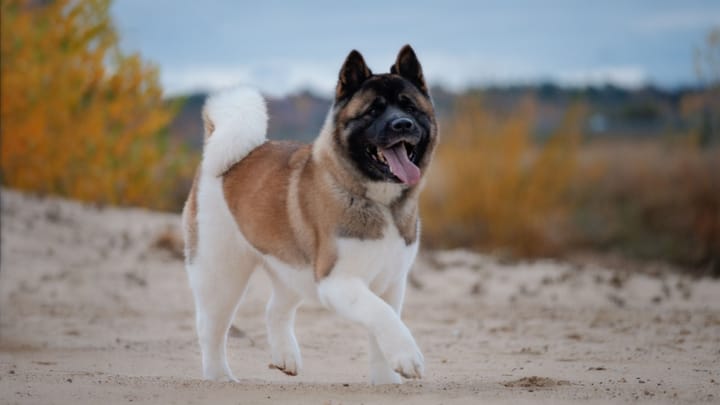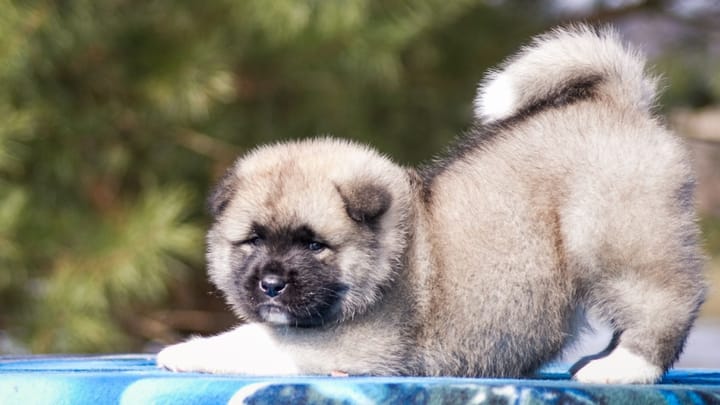American Akita
Other name: Akita


The American Akita is an extraordinary dog with its own character and is definitely not for everyone! Independent, proud, stubborn and often considered “disobedient”, they need constant, firm but gentle training at a young age. Often confused with Huskies, these dogs aren’t very athletic. They like peace and quiet and spending time with their family, to whom they can be both close and distant. American Akita are known to be difficult to handle. Therefore they are most suited to experienced owners who are ready to take the dog as it is.
|
Life expectancy |
The American Akita has a life expectancy of between 10 and 12 years |
|
Size |
Large
|
|
Adult size |
Female
Between 24 and 26 in
Male
Between 26 and 28 in
|
|
Adult weight |
Female
Between 99 and 132 lb
Male
Between 99 and 132 lb
|
|
Coat colour
All colours are accepted except merle. The Akita's colours include white,brindle or pinto, etc., this includes spotted / striped patterns. Totally white American Akitas have dark/black masks . Spotted dogs have white base coats and evenly distributed patches that cover more than a third of their body. Their undercoats can be a different colour to that of their main coat hair. |
Black White Brown Blue Red |
|
Type of coat
The hair is short to mid-length, up to 2 inches at their withers (ridge between their shoulder blades) and their hindquarters. Their coats are double layered: a thick, soft and dense undercoat and then a straight top coat, which has a hard/stiff texture. |
Short Long |
|
Eye colour
Their eyes are dark brown. |
Brown
|
|
Purchase price |
The American Akita costs between £510 and £780 |
Until the 2000s, the Akita Inu and the American Akita were not considered two different breeds and cross breeding between the two was common.
More details about the American Akita
American Akita: Origins and history
Originally, their history coincides with that of the Japanese Akita. From the 17th century, in the region of Akita, Akitas Matagis (or bear hunting dogs) were used as fighting dogs. From 1968, they were crossed with Tosa and Mastiff, which increased their size at the expense of other characteristics specific to Spitz-type dogs. During the Second World War, the police were ordered to capture all dogs (except German Shepherds) to make military clothing. Thus, many breeders tried to circumvent this law by simply breeding their dogs with German Shepherds. In fact, at the end of the war, three types of Akitas were distinguished, despite their numbers being significantly reduced: Matagis Akitas, Combat Akitas and Akitas/German Shepherds. It was then that many dogs were taken to the United States to further develop this breed. The first American Akita was born in 1956 and was first registered in 1972. Since then, Japan and the USA have never managed to agree on the origins of the paternity of the breed. Thus, nowadays, the American Akita and the Japanese Akita are very different, as no new Japanese blood has been integrated into that of the American Akita.
Physical characteristics of the American Akita
The American Akita (formerly known as the Large Japanese Dog) is a large, well-balanced dog with a solid build and heavy frame. Their eyes are relatively small and quite triangular. Their ears are upright and are quite small compared to the rest of their head. These ears are mostly triangular and are slightly rounded at their ends. Their tails are large and covered in thick hair, and often arch onto their backs, or dangling underneath their back.
FCI classification of the American Akita
-
Group 5 - Spitz and primitive types
-
Section 5 : Asian Spitz and related breeds
American Akita: Characteristics
American Akita: Behaviour
Training a American Akita
The American Akita is not a ‘working’ dog, so it doesn’t have the same ability to learn as a Sheepdog for example. They are sometimes stubborn, or rather very opportunistic, and do not appreciate constraints or obligations. Therefore it is important to take their personality into account when choosing training methods.
As a trainer, perseverance, self-confidence, patience and consistency are needed to achieve the desired results. Training sessions should be kept short, playful and regular as they quickly tire of repetition.
Mutual trust between the dog and their master is essential in order to achieve cooperation. If there is a lack of trust, then it will be very difficult to get the desired results.
Brutal methods of training are to be avoided because they will hinder the relationship between the dog and their master. A positive approach to training must be taken, whilst remaining firm and consistent.
However, do not expect the American Akita to be obedient. If they sense a lack of consistency, they will not obey commands. When they do decide to obey a command, it will be as and when they want and in their own time.
American Akita: Lifestyle
Breed compatibility American Akita
American Akita: Purchase price
American Akitas price varies according to their origin, age and sex. On average, the price of a pedigree dog is £780.
It will cost, on average, £60/month to meet the needs of this dog (quality food and health care etc)
American Akita: Shedding
Heavy !
It is important to be aware of the amount of hair that an Akita loses. Moulting periods can last for months and very thorough maintenance is necessary to get rid of all their dead hairs (daily brushing etc.). Some say it’s endless!
American Akita: Grooming
American Akita maintenance is tedious due to the amount of hair loss during moulting periods. Outside of these periods, only weekly brushing is needed, however this can take a long time due to their size.
Their ears and eyes should be inspected and cleaned regularly and it is also important to keep an eye on their skin which can quickly become problematic.
Baths are only required if the dog is particularly dirty, which may only be several times a year, depending on the dog’s activities.
American Akita: Health
Their estimated lifespan is 10 years.
American Akitas are often considered as robust due to their origins and build… but this is until they get sick which is, unfortunately, quite regular.
As with all dogs, heat is very rarely popular and requires, firstly, regular trips outside (early morning and late evening with the potential to cool off in water), and secondly, readily available fresh water and a shady corners to rest in!
Due to their double coat, American Akitas are very well protected against the cold and bad weather.
As for many dogs who don’t need too much food, one should pay attention to their diet to stop them gaining too much weight.
- Hip dysplasia
- Sebaceous adenitis (destruction of the sebaceous glands)
- VKH (Vogt-Koyanagi-Harada disease)
- Skin problems
- Epilepsy
- Hypothyroidism
- Progressive retinal atrophy






